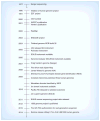The road from next-generation sequencing to personalized medicine
- PMID: 26000024
- PMCID: PMC4437232
- DOI: 10.2217/pme.14.34
The road from next-generation sequencing to personalized medicine
Abstract
Moving from a traditional medical model of treating pathologies to an individualized predictive and preventive model of personalized medicine promises to reduce the healthcare cost on an overburdened and overwhelmed system. Next-generation sequencing (NGS) has the potential to accelerate the early detection of disorders and the identification of pharmacogenetics markers to customize treatments. This review explains the historical facts that led to the development of NGS along with the strengths and weakness of NGS, with a special emphasis on the analytical aspects used to process NGS data. There are solutions to all the steps necessary for performing NGS in the clinical context where the majority of them are very efficient, but there are some crucial steps in the process that need immediate attention.
Keywords: CADD; GWAVA; NGS; functional prediction program; genomics; personalized medicine; workflow management system.
Figures



References
-
- Bloom DE, Cafiero ET, Jané-Llopis E, et al. The global economic burden of noncommunicable diseases. Geneva: World Economic Forum; www3.weforum.org/docs/WEF_Harvard_HE_GlobalEconomicBurdenNonCommunicable....
-
- Caskey CT, Gonzalez-Garay ML, Pereira S, Mcguire AL. Adult genetic risk screening. Annu Rev Med. 2014;65:1–17. - PubMed
-
- Wetterstrand KA. DNA sequencing costs: data from the NHGRI Genome Sequencing Program (GSP) www.genome.gov/sequencingcosts.
-
- NHGRI: all about the Human Genome Project (HGP) www.genome.gov/10001772.
Grants and funding
LinkOut - more resources
Full Text Sources
Other Literature Sources
Medical
